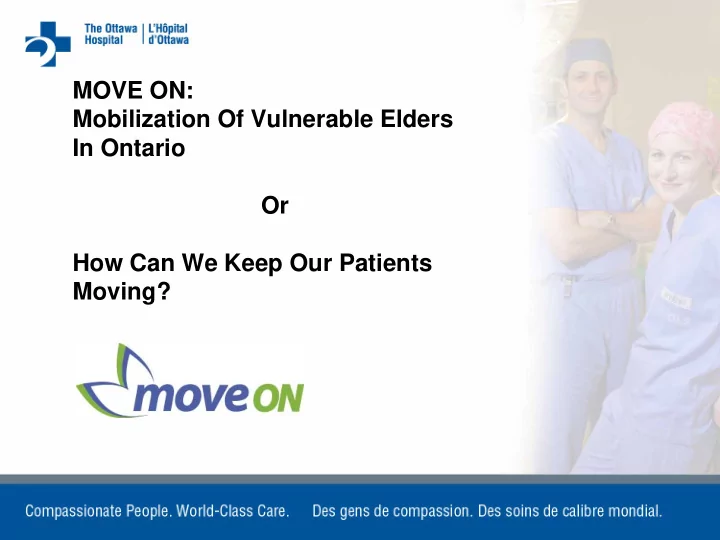

MOVE ON: Mobilization Of Vulnerable Elders In Ontario Or How Can We Keep Our Patients Moving?
Think up and move Objectives 3X per day After participating in this educational session, inter ‐ professional team members will be able to: • Understand the importance of mobility • Recognize that current mobilization practice is detrimental to our patients • Describe the principles/purpose of early mobilization
Think up and move 3X per day Some Numbers to Think About • In Ontario, seniors account for: • 19.5% of ED visits • 56% of acute hospital days • 83% of acute ALC days • Older age groups are projected to have the fastest rate of population growth in the province 2010/11 DAD data from www.intellihealth.moh.gov.on.ca
At Present Think up and move 3X per day Hospitalization = Immobility • Academic hospitals in Toronto: < 30% of patients were mobilized regularly Why? • Hospital environment discourages mobility & exacerbates disorientation • Mobility is restricted and mobility orders unclear • Dependence on staff is enforced Covinsky et al: JAMA, 2011 Oct 26; 306(16):1782 • Without mobilization, elderly patients lose 1 ‐ 5% of muscle strength each day (Annals Int Med 1993;118:219 ‐ 23)
Think up and move Psychological 3X per day Respiratory System •Anxiety •Depression •Decreased lung volume •Sensory deprivation •Pooling of mucous •Learned helplessness •Cilia less effective •Delirium •Decreased oxygen saturation •Aspiration atelectasis Circulatory System Gastrointestinal System •Loss of plasma volume •Increased risk of aspiration •Loss of orthostatic compensation •Loss of appetite •Increased heart rate •Decreased peristalsis •Development of DVT •Constipation Genitourinary System •Incomplete bladder emptying Musculoskeletal System •Formation of calculi in •Weakness kidneys and infection •Muscle atrophy/wasting •Loss of muscle strength by 3-5% •Calcium loss from bones Complications •Increased risk of falls due to weakness of Immobility
Think up and move 3X per day So how do we address this? • Ontario Local Health Integrated Networks’ Provincial Senior Friendly Strategy and hospital improvement plans across the province have been developed to: • Prevent functional decline through early mobilization • Prevent of delirium • Overall vision: enable seniors to maintain optimal health and function while they are hospitalized so that they can transition successfully home or to the next appropriate level of care
Think up and move 3X per day CAHO (Council of Academic Hospitals of Ontario) • Non ‐ profit association of Ontario’s 24 academic hospitals and their research institutes • Provides focal point for strategic initiatives on behalf of academic hospitals • MOVE ON = M obilization o f V ulnerable E lders in On tario • Knowledge transfer project approved by CAHO November 2011
Think up and move 3X per day • The Ottawa Hospital is one of 14 academic hospitals in Ontario participating in the MOVE ON project Objective: • To implement and evaluate the impact of an evidence based strategy to promote early mobilization and prevent functional decline in older patients admitted to hospitals in Ontario
Think up and move 3X per day Goal: • Progressive, scaled mobilization, at least three times daily Method: • Assess mobility within 24 hours • Design plan of care • Monitor progress, update targets to support OPTIMAL mobilization • Interprofessional team collaboration to encourage mobility
Why Focus on Mobility?
Think up and move Mobility 3X per day • Mobility is an essential life ‐ skill, but can be easily compromised by even brief periods of immobilization • A decline in mobility can start within 2 days of hospitalization! • Mobilization is known to prevent three serious complications of hospitalization that affect older adults: • Delirium • Functional Decline • Falls
Think up and move 3X per day Patients who walk around their room and their wards shortened their length of stay by 1.5 days, even more so for those who walked around the ward on the first day of admission (Shadmi & Zisberg, 2011)
Think up and move 3X per day What is mobility? • In the simplest terms, mobility is not lying in bed • Depending on the patient’s mobility level and capabilities, mobility includes: • Bed exercises • Sitting at the edge of the bed or chair • Transfers • Ambulating with or without a gait aid
Think up and move 3X per day Who can mobilize? Every patient! 2007 study found that mobilizing frail older adults is safe • Overall adverse event rate is very low: 14 in 1,449 activity events (0.96 %) • Adverse events include: • Falling to knees without injury • Change in BP (SBP < 90 or >200 mm Hg) • O2 desaturation <80% • Accidental tube removal Bailey et al, Crit Care Med 2007; 35:139 ‐ 145
Think up and move 3X per day Conclusion • Older adults: • Account for 56% of acute hospital admissions • Are projected to have the fastest rate of population growth in the province • Loose 1 ‐ 5% of muscle strength if not mobilized which leads to functional decline and loss of independence • project has been developed to promote early mobilization with these older patients and to prevent functional decline
Acknowledgements • The Ottawa Hospital is a member of the MOVE ON Collaboration, which is supported by the CAHO ARTIC program • The materials presented here are adapted from the MOVE iT initiative supported by the AFP Innovation Fund, OMA and MOHLTC.
Recommend
More recommend